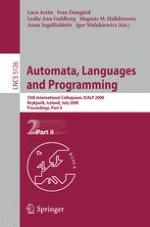The two-volume set LNCS 5125 and LNCS 5126 constitutes the refereed proceedings of the 35th International Colloquium on Automata, Languages and Programming, ICALP 2008, held in Reykjavik, Iceland, in July 2008. The 126 revised full papers presented together with 4 invited lectures were carefully reviewed and selected from a total of 407 submissions. The papers are grouped in three major tracks on algorithms, automata, complexity and games, on logic, semantics, and theory of programming, and on security and cryptography foundations. LNCS 5126 contains 56 contributions of track B and track C selected from 208 submissions and 2 invited lectures. The papers for track B are organized in topical sections on bounds, distributed computation, real-time and probabilistic systems, logic and complexity, words and trees, nonstandard models of computation, reasoning about computation, and verification. The papers of track C cover topics in security and cryptography such as theory, secure computation, two-party protocols and zero-knowledge, encryption with special properties/quantum cryptography, various types of hashing, as well as public-key cryptography and authentication.
